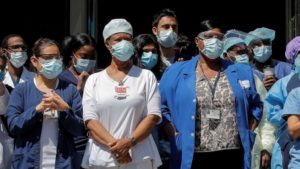COVID-19: Health Risks to Frontline Workers and Vulnerable Populations
Compiled by Katherine Bryant for Science for the People
Last updated: June 6, 2020
Disproportionate impact on People of Color
The fatality rate from COVID-19 for African-Americans is 2.4 the rate for whites. The high fatality rate is due to several factors, including greater comorbidities, environmental exposures, lack of adequate health care and greater overall stress. As of May, 2020, if the African-American death rate was equal to that of whites, 13,000 unnecessary deaths would have been prevented. Other groups with high disease and death rates from COVID19 are Latinx populations and Native Americans.
Healthcare and other frontline workers
The COVID-19 pandemic poses critical risks to healthcare workers. Early on, data from the Italian healthcare system indicated that adequate PPE is essential; and that up to 1 in 5 of SARS-CoV-2 cases occurred in these workers. In addition to the disproportionate risk to hospital staff, it also creates depletion of this workforce during the pandemic. However, recommended PPE equipment needs are not being met across the United States. From a labor perspective, the risks that healthcare workers shoulder during the COVID-19 crisis are already difficult to imagine for those of us not on the front lines. But without proper infrastructure and consistently applied procedures (i.e., physical distancing measures) we place these individuals and their families’ lives at even greater risk. Although we know from past experience what procedures and protocols are necessary, the lack of action on a federal and state level may lead to strikes or other measures by hospital staff who are being placed in unnecessary danger. In this way, labor issues will undoubtedly have significant repercussions for public health.
Due to the lack of federally enforceable health and safety guidelines from the Occupational Safety and Health Administration (OSHA), several health care and related labor unions (e.g., the National Nurses Union, the American Federation of Teachers, and AFSCME) have created their own guidelines for front-line workers that go beyond the current voluntary OSHA and CDC guidelines. The National Law Employment Project (NELP) has additional resources for workers who are concerned about OSHA and CDC guideline enforcement issues at their place of work.
The psychological consequences of the pandemic will likely be severe, especially for health care and other frontline workers. Mental health protections should include preventative, ongoing, and long-term treatment options. Unfortunately, many work environments cause employees to fear negative consequences for reporting problems and/or requesting help.
Homelessness
More than half a million Americans are homeless, and studies indicate this population faces infection, hospitalization, and mortality risks much greater than the non-homeless population. Providing housing is the single most important intervention that can lower the risk of illness and death in this population. The homeless are at additional risk because they have higher rates of chronic conditions like kidney, liver, and heart disease, which are risk factors for severe illness. Additionally, there are indicators that more people will be driven into homelessness due to the economic slowdown and lack of robust rent relief and eviction moratoria. Further, nationwide shutdowns have led to a loss of social support programs that provide food, shelter, and other services for the homeless. The National Alliance to End Homelessness has produced a white paper reporting on these issues and providing recommendations for supporting the homeless and mitigating their risk during the pandemic. The NAEH calls on local, state, and federal agencies to step up in their responses to provide housing and support to both address the reduction in services as well as provide greater and better shelter options in order to respond to the current crisis.
Other Vulnerable Groups
Other groups with high vulnerability to the effects of COVID-19 are immigrants and refugees; workers in the “gig” economy who have no job security or health insurance; prisoners; women, who tend to be concentrated in “face-to-face” jobs and are facing additional childcare burdens due to school and day care closings; and low-income workers, who must choose between economic survival and risking their health.
